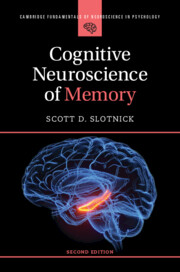Refine search
Actions for selected content:
74 results

Cognitive Neuroscience of Memory
-
- Published online:
- 12 June 2025
- Print publication:
- 30 January 2025
-
- Textbook
- Export citation
Chapter 7 - Belief, Judgment, and Knowledge
-
- Book:
- Explaining our Actions
- Published online:
- 17 April 2025
- Print publication:
- 08 May 2025, pp 135-157
-
- Chapter
- Export citation
Chapter Seven - Word Meanings and Concept Representations
-
- Book:
- The Neuroscience of Language
- Published online:
- 17 April 2025
- Print publication:
- 10 April 2025, pp 144-170
-
- Chapter
- Export citation
Chapter Three - Brain Regions Associated with Long-Term Memory
-
- Book:
- Cognitive Neuroscience of Memory
- Published online:
- 12 June 2025
- Print publication:
- 30 January 2025, pp 51-78
-
- Chapter
- Export citation
Structure in Semantic Memory: A Probabilistic Approach using a Continuous Response Task
-
- Journal:
- Psychometrika / Volume 52 / Issue 1 / March 1987
- Published online by Cambridge University Press:
- 01 January 2025, pp. 19-41
-
- Article
- Export citation
An EEG study to understand semantic and episodic memory retrieval in creative processes
-
- Journal:
- Proceedings of the Design Society / Volume 4 / May 2024
- Published online by Cambridge University Press:
- 16 May 2024, pp. 1147-1156
-
- Article
-
- You have access
- Open access
- Export citation
Contrasting the semantic typology biases of Deaf and hearing nonsigners in their conceptualization of time and space
-
- Journal:
- Applied Psycholinguistics / Volume 44 / Issue 6 / November 2023
- Published online by Cambridge University Press:
- 31 October 2023, pp. 1090-1123
-
- Article
- Export citation
Chapter 5 - Episodic Memory
-
- Book:
- Cognitive Ontology
- Published online:
- 15 January 2023
- Print publication:
- 05 January 2023, pp 123-157
-
- Chapter
- Export citation
10 - The Ease of Language Understanding Model
- from Part II - Models and Measures
-
-
- Book:
- The Cambridge Handbook of Working Memory and Language
- Published online:
- 08 July 2022
- Print publication:
- 21 July 2022, pp 197-218
-
- Chapter
- Export citation
The Role of Silence in Verbal Fluency Tasks – A New Approach for the Detection of Mild Cognitive Impairment
-
- Journal:
- Journal of the International Neuropsychological Society / Volume 29 / Issue 1 / January 2023
- Published online by Cambridge University Press:
- 24 January 2022, pp. 46-58
-
- Article
-
- You have access
- Open access
- HTML
- Export citation
6 - Memory and Recall Overview
- from Part II - Memory and Recall
-
-
- Book:
- The Cambridge Handbook of Animal Cognition
- Published online:
- 01 July 2021
- Print publication:
- 22 July 2021, pp 117-139
-
- Chapter
- Export citation
Autobiographical Memory Fluency Reductions in Cognitively Unimpaired Middle-Aged and Older Adults at Increased Risk for Alzheimer’s Disease Dementia
-
- Journal:
- Journal of the International Neuropsychological Society / Volume 27 / Issue 9 / October 2021
- Published online by Cambridge University Press:
- 29 January 2021, pp. 905-915
-
- Article
- Export citation
11 - Processes of Utterance Interpretation: For a Neuropragmatics
- from Part IV - The Processing of Speech Meaning
-
- Book:
- The Study of Speech Processes
- Published online:
- 14 January 2021
- Print publication:
- 21 January 2021, pp 220-238
-
- Chapter
- Export citation
Neural meaning making, prediction, and prefrontal–subcortical development following early adverse caregiving
-
- Journal:
- Development and Psychopathology / Volume 32 / Issue 5 / December 2020
- Published online by Cambridge University Press:
- 11 January 2021, pp. 1563-1578
-
- Article
- Export citation
27 - On the Interaction Between Episodic and Semantic Representations – Constructing a Unified Account of Imagination
- from Part IV - Novel Combinatorial Forms of the Imagination
-
-
- Book:
- The Cambridge Handbook of the Imagination
- Published online:
- 26 May 2020
- Print publication:
- 18 June 2020, pp 447-465
-
- Chapter
- Export citation
Epilogue
-
- Book:
- The Neuroethics of Memory
- Published online:
- 18 July 2019
- Print publication:
- 08 August 2019, pp 196-201
-
- Chapter
- Export citation
Semantic Memory Activation After Acute Exercise in Healthy Older Adults
-
- Journal:
- Journal of the International Neuropsychological Society / Volume 25 / Issue 6 / July 2019
- Published online by Cambridge University Press:
- 25 April 2019, pp. 557-568
-
- Article
-
- You have access
- HTML
- Export citation
Autobiographical Memory From Different Life Stages in Individuals With Obstructive Sleep Apnea
-
- Journal:
- Journal of the International Neuropsychological Society / Volume 25 / Issue 3 / March 2019
- Published online by Cambridge University Press:
- 30 January 2019, pp. 266-274
-
- Article
-
- You have access
- HTML
- Export citation
Do Alzheimer’s Disease Patients Benefit From Prior-Knowledge in Associative Recognition Memory?
-
- Journal:
- Journal of the International Neuropsychological Society / Volume 25 / Issue 4 / April 2019
- Published online by Cambridge University Press:
- 30 January 2019, pp. 443-452
-
- Article
- Export citation
Identification of odors, faces, cities and naming of objects in patients with subjective cognitive decline, mild cognitive impairment and Alzheimer´s disease: a longitudinal study
-
- Journal:
- International Psychogeriatrics / Volume 31 / Issue 4 / April 2019
- Published online by Cambridge University Press:
- 21 September 2018, pp. 537-549
-
- Article
- Export citation
